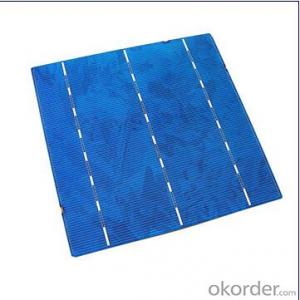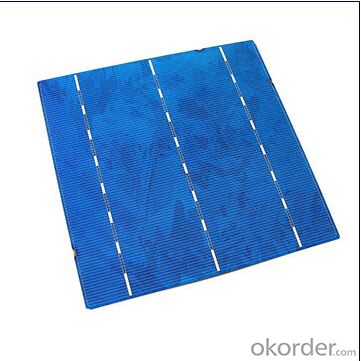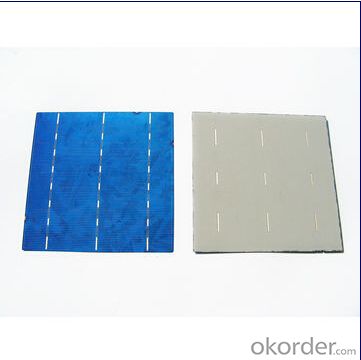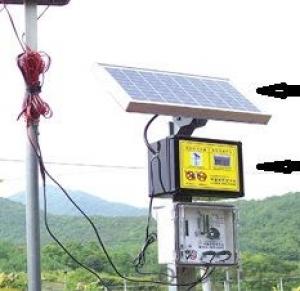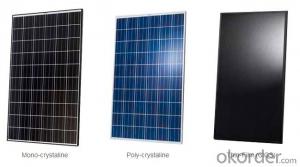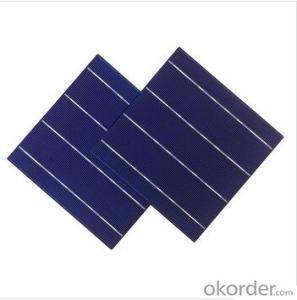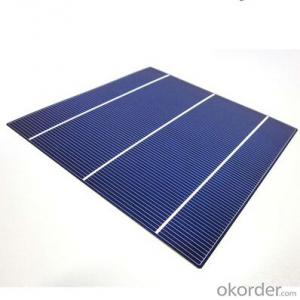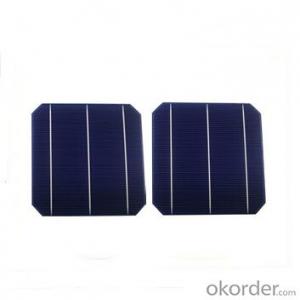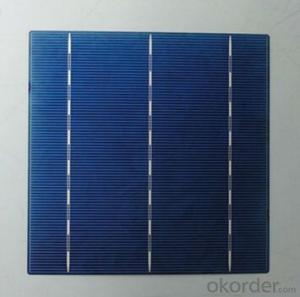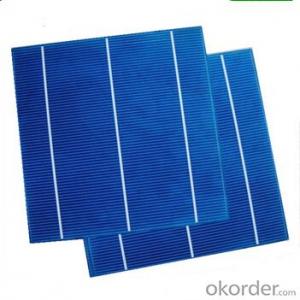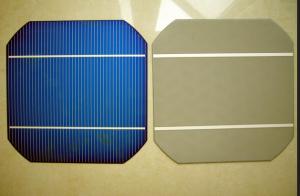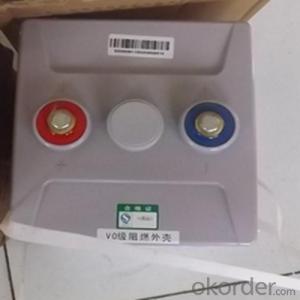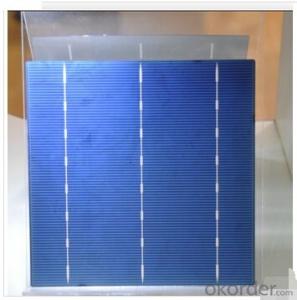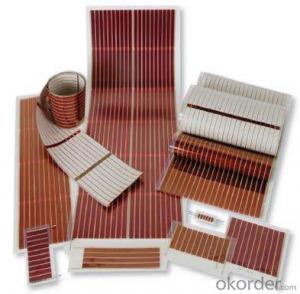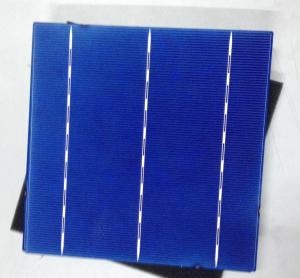Kesterite Solar Cells - Polycrystalline High Quality 17.2% Efficiency
- Loading Port:
- Shanghai
- Payment Terms:
- TT OR LC
- Min Order Qty:
- 1000 pc
- Supply Capability:
- 100000 pc/month
OKorder Service Pledge
OKorder Financial Service
You Might Also Like
Solar Cells:
Solar cells is made by solar wafer, it has three categories of solar cell right now, monocrystalline polycrystalline and thin film,These cells are entirely based around the concept of PN junction, which is the critical part of solar module, it is the part that can convert the light energy into electricity, the thickness is from 180um to 200um, with even busbars to conduct electricity, textured cell can decrease diffuse reflection; they are often electrically connected and encapsulated as a module. Photovoltaic modules often have a sheet of glass on the front (sun up) side, allowing light to pass while protecting semiconductor wafers from abrasion and impact due to wind-driven debris, rain, hail, etc. Solar cells are also usually connected in series in modules, creating an additive voltage. Connecting cells in parallel will yield a higher current;With high quality and stable quality. Our Cells can greatly improve the performance of Solar Modules.
Solar Cells Advantage:
• High efficiency and stable performance in photovoltaic conversion.
• Advanced diffusion technique ensuring the homogeneity of energy conversion efficiency of the cell.
• Advanced PECVD film forming, providing a dark blue silicon nitride anti-reflection film of homogenous color and attractive appearance.
• High quality metal paste for back surface and electrode, ensuring good conductivity, high pulling strength and ease of soldering.
• High precision patterning using screen printing, ensuring accurate busbar location for ease with automatic soldering a laser cutting.
Features:
High efficiencies up to 16.4%
Proven long term mechanical stability of silicone
Make of highly purified poly silicone
Three bus bars for reduced series resistance and improved module and cell efficiency
Blue anti-reflecting coating ensures improved light absorption and increased efficiency
Acid texturization offers a uniform appearance and virtually invisible crystal structure
Excellent low light behavior for improved energy yield
Specifications
Max power | 4.1W |
Short-circuit current(Isc) | 8.41A |
Imax at 0.5V | 8A |
Open circuit voltage(Voc) | 0.62V |
Size | 156*156mm |
Efficiency | 16.80% |
FAQ
We have organized several common questions for our clients,may help you sincerely:
①What price for each watt?
It depends on the efficiency of the solar cell, quantity, delivery date and payment terms.
②How long can we receive the product after purchase?
In the purchase of product within three working days, We will arrange the factory delivery as soon as possible. The pecific time of receiving is related to the state and position of customers.Commonly 7 to 10 working days can be served.
③Can you provide the peripheral products of the solar panels, such as the battery, controller, and inverter? If so, can you tell me how do they match each other?
Yes, we can, we have two companies for solar region, one is CNBM International, the other is CNBM engineering Co.
We can provide you not only the solar module but also the off grid solar system, we can also provide you service with on grid plant.
④What is your warranty of solar cell?
Our product can promise lower than 0.3% open box crack, we support claim after opening the box if it has crackm color difference or sth, the buyer should give pictures immediately, we can not accept the claim after the solar cell has assembled to solar panel.
• Timeliness of delivery
• ⑤How do you pack your products?
We have rich experience on how to pack the solar cell to make sure the safety on shipment, we could use wooden box or pallet as buyer's preference.
- Q: How many solar cells are there in a solar panel?
- I need to know the power of the solar panel to answer the question.
- Q: Are solar cells impacted by shading?
- Yes, solar cells are significantly impacted by shading. Even a small amount of shading, such as from trees or buildings, can drastically reduce the efficiency and output of a solar cell. Shading causes certain parts of the cell to receive less sunlight, resulting in decreased energy production. Therefore, it is important to install solar panels in areas with maximum sunlight exposure to optimize their performance.
- Q: Can solar cells be used for indoor lighting?
- Yes, solar cells can be used for indoor lighting. However, they are generally less efficient indoors compared to outdoor environments due to the reduced amount of sunlight available. Additionally, indoor lighting usually requires a constant and reliable power source, which may be challenging to achieve solely through solar cells.
- Q: How do solar cells perform in dusty environments?
- Solar cells can experience a decrease in performance in dusty environments as dust particles can block sunlight from reaching the surface of the cells, reducing their efficiency. Regular cleaning and maintenance are necessary to ensure optimal performance in such conditions.
- Q: What is the typical warranty for solar cells?
- The typical warranty for solar cells varies, but it is commonly around 25 to 30 years for the performance warranty and 10 to 15 years for the product warranty.
- Q: Can solar cells be used in drones?
- Yes, solar cells can be used in drones. In fact, many drones are equipped with solar panels to harness solar energy and power their operations. This helps to extend flight time, reduce reliance on traditional batteries, and make drones more sustainable and energy-efficient.
- Q: Can solar cells generate electricity at night?
- No, solar cells cannot generate electricity at night. They require sunlight to produce electricity as they convert sunlight into electrical energy.
- Q: Can solar cells be used in hot climates?
- Yes, solar cells can definitely be used in hot climates. In fact, solar panels tend to function more efficiently in hot weather as higher temperatures increase the conductivity of the cells, enhancing their overall performance. However, it is important to note that excessive heat may also decrease the lifespan of solar panels over time. Therefore, proper design considerations and cooling mechanisms are often employed to ensure optimal performance and longevity in hot climate installations.
- Q: What is the impact of solar cell installations on greenhouse gas emissions?
- Solar cell installations have a significant positive impact on reducing greenhouse gas emissions. By harnessing the power of the sun to generate electricity, solar cells eliminate the need for fossil fuel-based energy sources, which are major contributors to greenhouse gas emissions. As more solar cells are installed and integrated into the energy grid, the overall emissions from the electricity sector decrease, making solar cell installations an important solution towards mitigating climate change.
- Q: Can solar cells be used in parking lots?
- Yes, solar cells can be used in parking lots. Solar panels can be installed on the roofs of parking structures or on canopies to capture sunlight and convert it into electricity. This renewable energy source can power lighting systems, charging stations for electric vehicles, and other electrical equipment in parking lots, making them more sustainable and reducing reliance on the grid.
Send your message to us
Kesterite Solar Cells - Polycrystalline High Quality 17.2% Efficiency
- Loading Port:
- Shanghai
- Payment Terms:
- TT OR LC
- Min Order Qty:
- 1000 pc
- Supply Capability:
- 100000 pc/month
OKorder Service Pledge
OKorder Financial Service
Similar products
Hot products
Hot Searches
Related keywords
